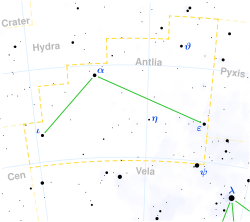Alpha Antliae
 Location of α Antliae to the upper left of center | |
| Observation data Epoch J2000.0 Equinox J2000.0 (ICRS) | |
|---|---|
| Constellation | Antlia |
| Right ascension | 10h 27m 09.10037s[1] |
| Declination | −31° 04′ 03.9961″[1] |
| Apparent magnitude (V) | 4.22 to 4.29[2] |
| Characteristics | |
| Spectral type | K4 III[3] |
| U−B color index | +1.63[4] |
| B−V color index | +1.45[4] |
| R−I color index | +0.79[4] |
| Variable type | Suspected[2] |
| Astrometry | |
| Radial velocity (Rv) | 12.2 ± 2[5] km/s |
| Proper motion (μ) | RA: –81.61 ± 0,32[1] mas/yr Dec.: +10.53 ± 0,50[1] mas/yr |
| Parallax (π) | 8.91 ± 0.49[1] mas |
| Distance | 370 ± 20 ly (112 ± 6 pc) |
| Details | |
| Mass | 2.2[6] M☉ |
| Radius | 53[7] R☉ |
| Luminosity (bolometric) | 555[6] L☉ |
| Surface gravity (log g) | 1.77[8] cgs |
| Temperature | 3990[8] K |
| Metallicity [Fe/H] | -0.39[8] dex |
| Other designations | |
| Database references | |
| SIMBAD | data |
Alpha Antliae (Alpha Ant, α Antliae, α Ant) is the brightest star in the constellation of Antlia but it has not been given a proper name.[10] It is approximately 370 light-years from the Solar System. It is a K-type giant star that varies in apparent visual magnitude between 4.22 and 4.29. This star has 2.2 times the mass of the Sun and has expanded to 53 times the solar radius. Compared to the Sun, it has only 41% of the abundance of elements other than hydrogen and helium.[2][9]
References
- 1 2 3 4 5 van Leeuwen, F. (November 2007), "Validation of the new Hipparcos reduction", Astronomy and Astrophysics, 474 (2): 653–664, arXiv:0708.1752
 , Bibcode:2007A&A...474..653V, doi:10.1051/0004-6361:20078357.
, Bibcode:2007A&A...474..653V, doi:10.1051/0004-6361:20078357. - 1 2 3 NSV 4862, database entry, New Catalogue of Suspected Variable Stars, the improved version, Sternberg Astronomical Institute, Moscow, Russia. Accessed on line October 3, 2008.
- ↑ Houk, Nancy (1983). Michigan catalogue of two-dimensional spectral types for the HD stars. Michigan Spectral Survey. 3. University of Michigan. Retrieved 2009-10-22.
- 1 2 3 Hoffleit, D.; Warren, Jr., W. H. "HR 4104". The Bright Star Catalogue (5th revised ed.). Centre de Données astronomiques de Strasbourg. Retrieved 2008-10-03.
- ↑ Evans, D. S. (June 20–24, 1966). "The Revision of the General Catalogue of Radial Velocities". In Batten, Alan Henry; Heard, John Frederick. Determination of Radial Velocities and their Applications, Proceedings from IAU Symposium no. 30. University of Toronto: International Astronomical Union. Bibcode:1967IAUS...30...57E. Retrieved 2009-09-10.
- 1 2 Alpha Antliae, Stars, Jim Kaler. Accessed on line October 3, 2008.
- ↑ HD 90610, database entry, Catalog of Apparent Diameters and Absolute Radii of Stars (CADARS), 3rd edition, L. E. Pasinetti-Fracassini, L. Pastori, S. Covino, and A. Pozzi, CDS ID II/224. Accessed on line October 3, 2008.
- 1 2 3 McWilliam, Andrew (December 1990). "High-resolution spectroscopic survey of 671 GK giants. I - Stellar atmosphere parameters and abundances". Astrophysical Journal Supplement Series. 74: 1075–1128. Bibcode:1990ApJS...74.1075M. doi:10.1086/191527.
- 1 2 NSV 4862 -- Variable Star, database entry, SIMBAD. Accessed on line October 3, 2008.
- ↑ Schneider, Howard; Wood, Sandy (2009). National Geographic Backyard Guide to the Night Sky. National Geographic Books. p. 173. ISBN 1-4262-0281-4.
Coordinates: ![]() 10h 27m 09.1011s, −31° 04′ 04.004″
10h 27m 09.1011s, −31° 04′ 04.004″
This article is issued from Wikipedia - version of the 10/14/2016. The text is available under the Creative Commons Attribution/Share Alike but additional terms may apply for the media files.